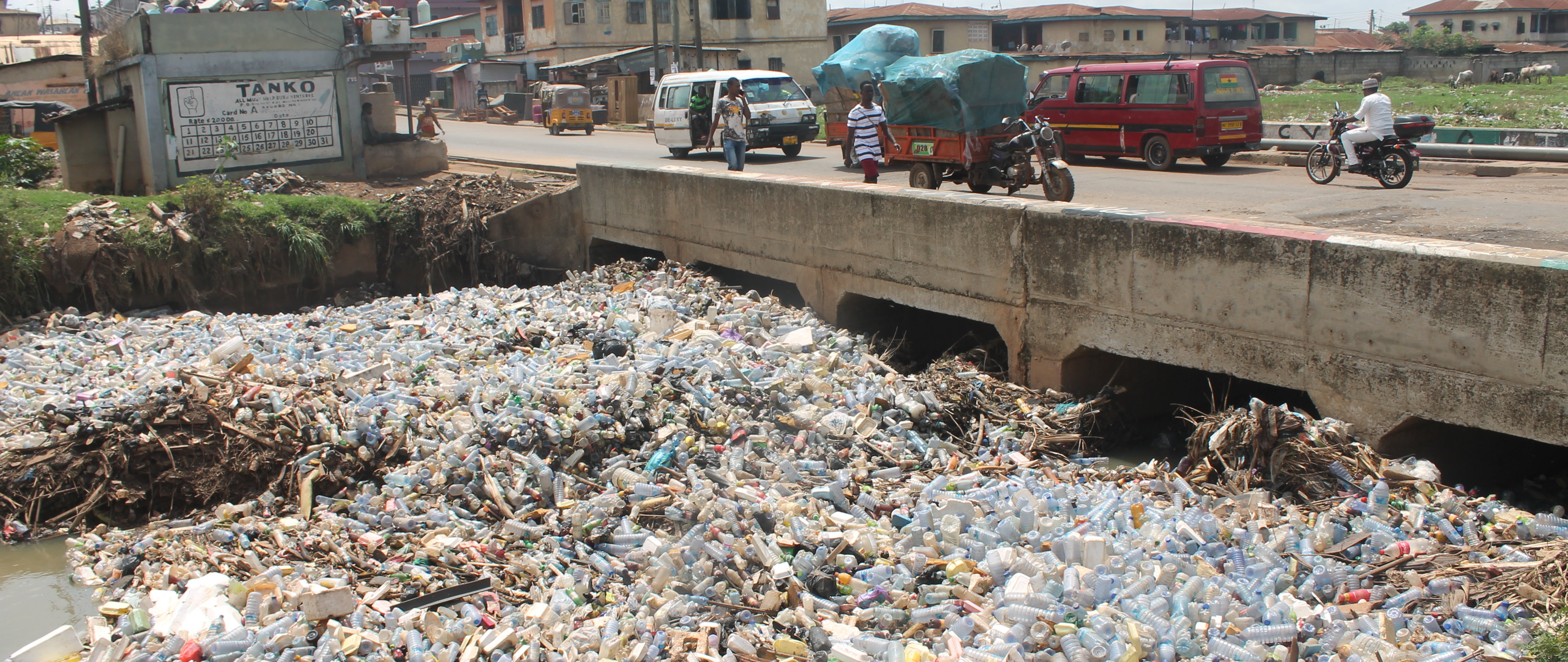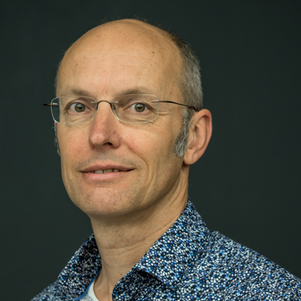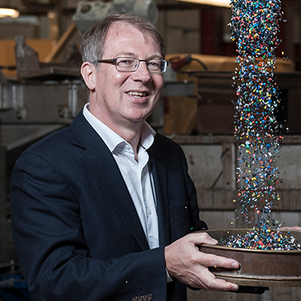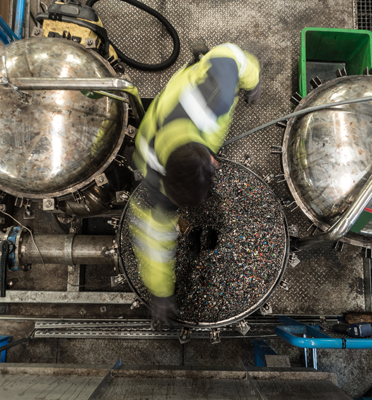The oceans of the world are filling up with plastic waste carried there by rivers. Where it all comes from no one knows. Wim Uijttewaal, professor of Experimental Hydraulics and professor of Resources & Recycling Peter Rem are on a mission to make the rivers plastic free. ‘We want to turn the removal of plastic from rivers into big business. And we want to devise a plastic waste radar that will show where the plastic is, and how it got there.’
Economic value
Looking at it from a distance the problem seems to be of an overwhelming magnitude. And yet in terms of economic value it only represents a few hundred million euros. Rem: ‘Some eight million tons of plastic waste end up in the rivers every year. If you remove it, deposit it and burn it the cost per ton comes to around 100 euros.’ However, very few parties would be able to break even, let alone make a profit. Uijttewaal: ‘There is not enough know-how and the value is too fractured.’
A many-sided product
That is why Uijttewaal and Rem approach making rivers plastic free as a marketable product. Cleaning up the river could result in a quality plastic recycled from plastic waste, for instance, or in the elimination of mosquitos and disease because the water can flow freely once more.
Clean beaches for tourists would be another commodity to be sold. ‘The question we ask is: how much is this worth to a potential client? And can all the money put together rid the river of all the plastic? Rem: ‘A single plastic bottle fished out of the river immediately represents a certain monetary value. But small pieces of plastic foil, for example, are much more difficult to retrieve and because recycling them cheaply is not possible and burning them would be too damaging to the environment they are not worth it from a money making point of view. ’
And that is where local authorities come in. They would be in a position to say ‘As no one is willing to spend the money to remove this type of plastic, we will ban all products using it from the local market’. It’s similar to what happened with the plastic shopping bags in the Netherlands and Europe.
A climate model for plastic
Supported by TU Delft/Global Initiative, Uijttewaal initiated and now heads the Plastic Free Rivers-programme. ‘There are dozens of parties that are trying to tackle the plastic waste problem, each in their own way and each in their own area of expertise. But what is missing, apart from the necessary know-how, is an integral approach. That is what we are focusing on at TU Delft. Our first move was to organise a round table with a number of scientific experts, social partners and businesses. This resulted in a consortium surprisingly quickly.’
The aim is to create a model which can be used by the (local) authorities or investors to ascertain in a relatively short space of time if an investment will be viable. Uijttewaal: ‘What the model will tell them once the data has been processed is how much it will cost to remove a ton of plastic from the river in a certain site and how much it’s worth. It will put the stakeholders in the picture and how much they would be willing to contribute. The site in question could be the location for a beach attracting lots of tourists, or it could be the site of a sewage pipe that is no longer blocked. How much would that be worth to them?’ Stakeholders would, of course, want to see some proof before they commit themselves. Rem: ‘It is already a given that we would have to provide multiple quality guarantees. If the tourist sector in Indonesia were to contribute, for example, it would want to make sure the money goes towards something useful, such as a monitoring system to see if the beaches are really getting cleaner.’
The model would be an open source tool accessible to all scientists, including those not connected with the programme. Rem: ‘It’s similar to the way climate models are made. There is not a researcher in the world who can create a climate model on his own but with the help of other researchers it can be done. With a bit of organisation we can make use of each other’s expertise.’
Three countries, three rivers
Uijttewaal emphasises the hypothetical nature of the situation. ‘We want to show that we have a business case and that it can work. That’s why we are testing the model in Indonesia, Ghana and the Netherlands. As a scientists you want to know if your model holds up under different conditions. If it works in these very different places, chances are it will work anywhere.’
How to make plastic waste pay
An important element of the business case is the value of the plastics themselves. Mixed plastics are worth around 200 euros a ton but once they have been separated the value shoots up to 800 euros. The problem is that the separation process is a lengthy one. ‘Your intuition tells you that a pile consisting of 250 kinds of plastic would have to pass through your hands 250 times.’ A new sorting method called logarithmic sorting developed by Rem brings the process down to eight steps. ‘If you study the process closely you will find to your surprise that the number of actions is proportional to the logarithm of the number of types of plastic.’ The pile is divided into two groups of 125 types of plastic each – that is step one. Then the two groups are divided into 62 – and that is step 2. ‘If you do this eight times that is your who pile sorted. And that will give you a 600 euro increase in value.’
For the Netherlands and Europe Rem is looking at machines that can distinguish colour and chemical composition. ‘For Indonesia and Ghana we want something along the same principles but cheaper and more flexible, for instance a process that consists of 80% sorting by hand and 20% by machine. The human eye is perfectly capable of making the distinction between a light blue and a totally transparent bottle, and whether it is a PET bottle or not. To spot some additives you would need a machine using ultraviolet light but that could be a final step and perhaps not one that would have to be taken then and there.
‘In countries where the problem is most pressing and where wages are very low plastic waste removal would boost economic activity. With the help of local parties we can create the right conditions for this to happen,’ Uijttewaal adds.
Detection, mining, recycling
Recycling is the third step in the plastics retrieval cycle. It is preceded by ‘mining’, which is where Uijttewaal’s expertise comes to the fore. ‘Normally I would look at fine-grained material in rivers, such as pebbles and sand. Plastic doesn’t have a definite shape. How does it behave in water? A plastic bag almost seems to float. And how do you separate the plastic from the water and put it into a collection system?
Before the plastic can be harvested it needs to be detected. To locate the material satellites and drones are used. Uijttewaal: ‘At the moment we don’t know which image resolution we need to use to see the difference between the trunk of a tree and a load of plastic. We will have to do more tests.’
A rain radar for plastic
Combining satellite and drone images with local activities will shed light on the types of plastics found and where they have come from. The information is put on an online platform, creating a kind of plastic radar accessible to all.
Finding out where the plastic originated opens up many new possibilities, Uijttewaal says. ‘Pollution is often anonymous: I have thrown it away so I’m no longer responsible. If that anonymity is taken away manufacturers can no longer hide. We can tell them, ‘Hey, we are finding your stuff in such and such a place, do something about it!’ Detection can also yield more general insights, Rem adds. ‘You could find, for instance, that pvc foils are a problem everywhere, not just in a particular region. That means that you could potentially reach a global public and call for a worldwide ban on foils.’
The programme has taken both scientists’ beyond their normal sphere of action. Rem: ‘This is first and foremost a public programme. It is society that worries about plastic pollution and wants the rivers to be cleaned up. One party alone cannot make this happen. We are very happy that Dutch universities are taking on a leading role.’







